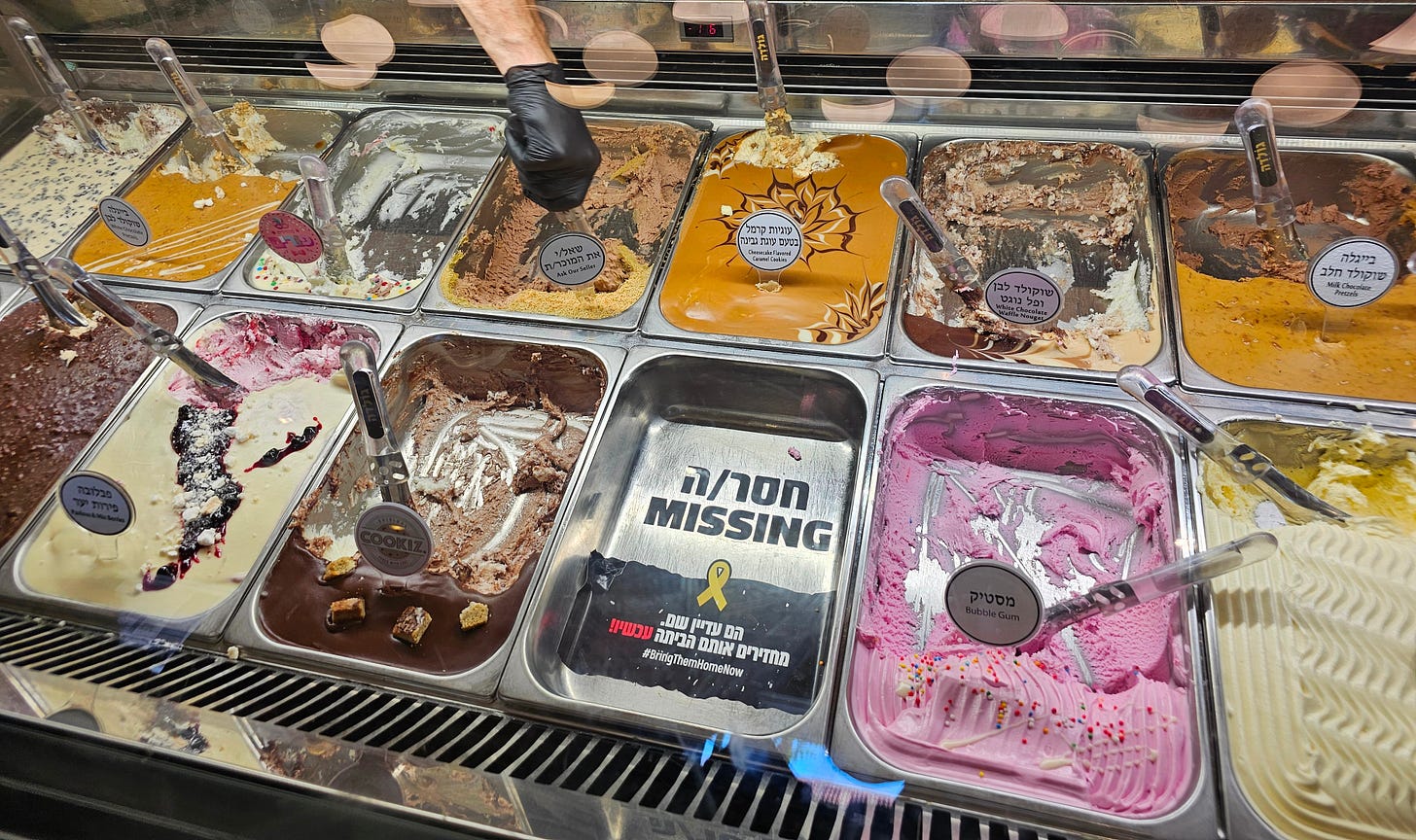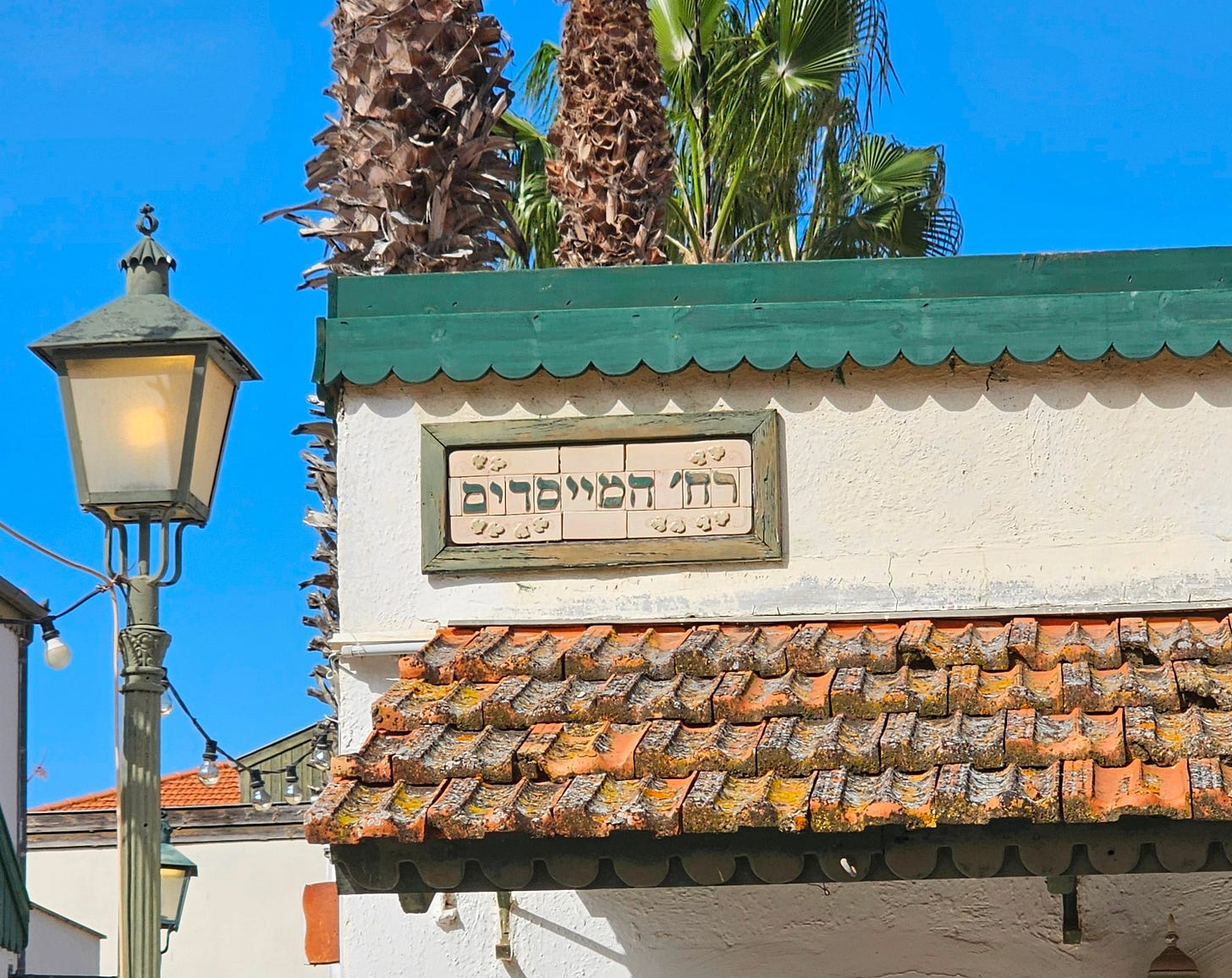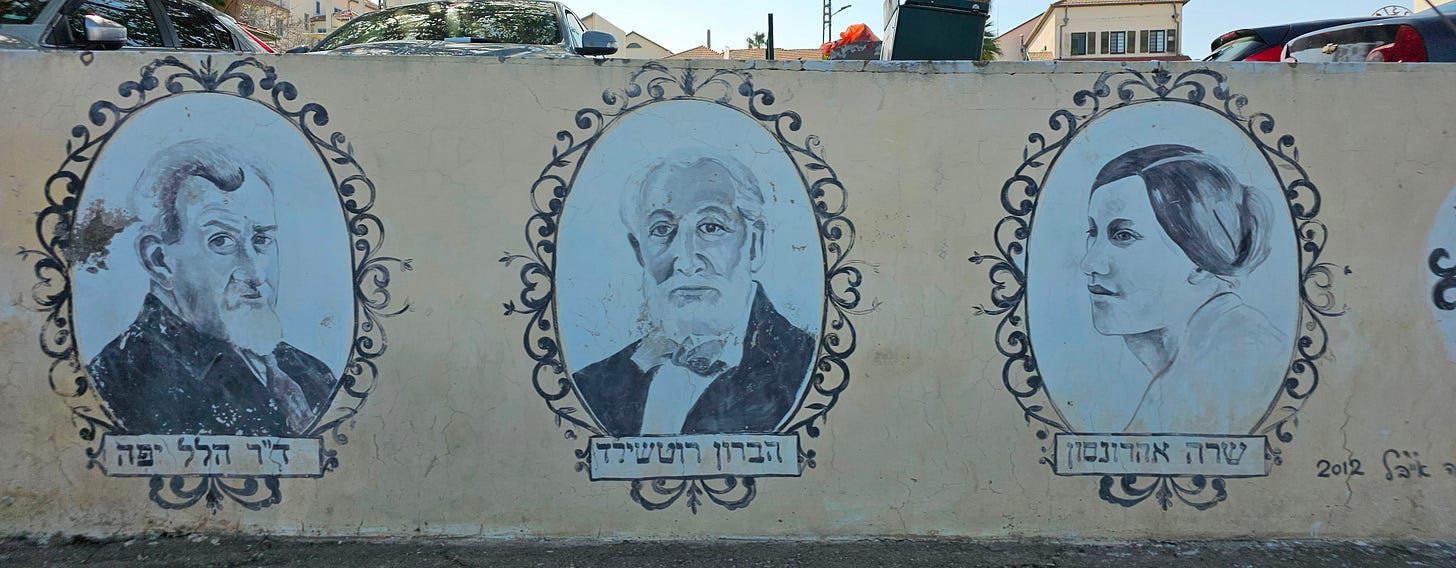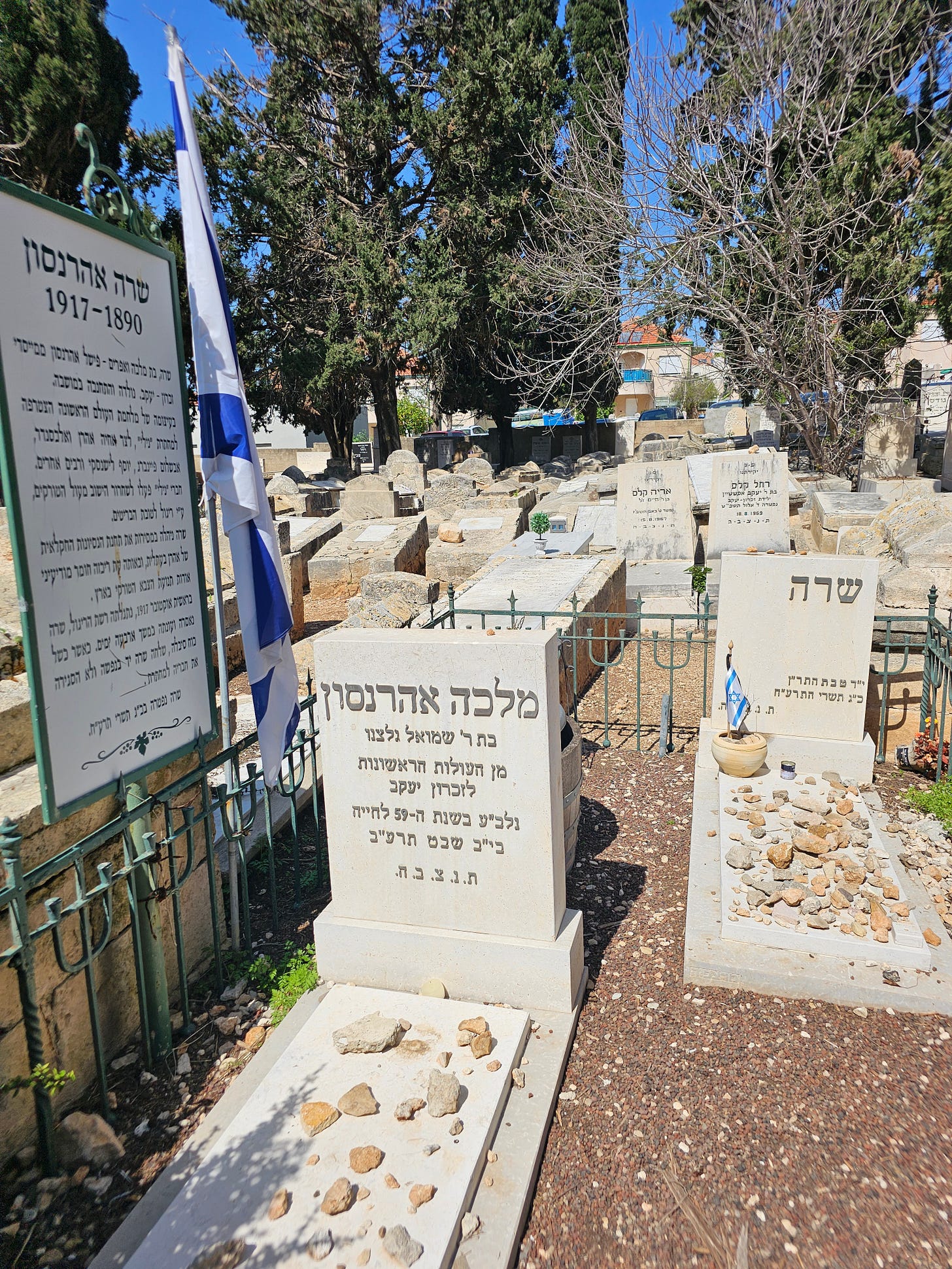Late last night I arrived in Petach Tikva to stay with my aunt Esther (appropriate, having just completed reading her Megilla earlier in the evening for Erev Purim). This morning, we were up early for a 45 minute drive to the town of Zichron Yaakov. We arrived around 9am, parked (no easy task in a small town of Israeli drivers), and sat down for a coffee on the main pedestrian street called Rehov Ha’Meyasdim: Founders’ Street.
Zichron Yaakov is a small town in the Carmel Mountain Range. It is about 40km south of Haifa, and has stunning views of the coastal plain across to the Mediterranean. It has a fascinating history linked to the First Aliya, and was the ideal experience to cap off my five day whirlwind trip to Israel.
Zichron Yaakov
The town was founded in 1882 by about 100 new immigrants to Palestine from Romania. They had faced unprecedented levels of antisemitism back home, and so opted to leave everything behind and travel to Palestine to build a new home for themselves, albeit in Ottoman controlled territory. They soon arrived in Palestine, and made their way to their new home - a small area in the hills called Zammarin.
The families worked hard, and though many suffered from bouts of malaria and typhus, some opting to return to Romania rather than endure the difficult conditions in Palestine, the descendants of those who opted to remain are largely still there to-date. In 1882, the community turned to Baron de Rothschild, a French philanthropist, seeking an infusion of capital into their new project, to get everything truly off the ground. They were given the funds and the know-how, and in turn changed the name of their town to Zichron Yaakov, or “In memory of Jacob,” the Baron’s father.
Aaronsohn Family
The town became an agricultural centre, and the community grew. Within that community was the Aaronsohn family: Efraim and Malka, and their six children. Their eldest, Aaron, was a prodigy. He was a brilliant agronomist and set up an agricultural research station in the coastal town of Atlit, nearby, to help better understand Palestine’s topography. He was only able to do so with the generosity of donations from wealthy American Jews, impressed by his efforts. His little sister, Sarah, became his assistant, confidante, and best friend.
At the time, the Ottoman Turks controlled Palestine. When World War 1 broke out in 1914, and the Armenian Genocide transpired in 1915 (leading to the wholesale slaughter of 1.5 million Armenians by Turkish hands), the Jews began to worry for their own safety. They were terrified of also falling victim to the Turks, and so Aaron and Sarah set up the NILI spy ring, to help spy for the British, and assist them in defeating the Ottomans during WW1. If the British won the war, they would oust the Turks from Palestine, and hopefully let the Jews (a) live, and (b) set up their own sovereign station on their ancestral homeland.
In the end, the spy ring brought massive success to Britain during the war. The British forced the Ottomans out of Palestine by December 1917, and they have directly credited Sarah Aaronsohn, and the work of her small spy ring, to helping them achieve their victory. Tragically, Sarah died by suicide (rather than being subjected to Ottoman torture) before she could see her efforts bear fruit. She died on October 9, 1917, three weeks before the Balfour Declaration was issued, and two months before the British conquered Palestine and Lord Allenby entered Jerusalem.
I’ve always been perplexed by this story, and wanted to see Zichron Yaakov, where so many of these events happened. Esther and I visited the Aaronsohn House, had a guided tour, and were taken back in time to frontier wilderness, fearing the Ottoman Turks, locust plagues, Sinai desert military maneuvers, and ultimately the start of the British Mandate. It was fascinating, and we took some time afterwards to visit Sarah’s grave nearby to pay our respects, and then explore the beautiful and fascinating town.
Why?
Going back in time, after the experience of the last week, felt like the ideal way to cap off my trip. It enabled me, in a way, to shed so much of the excess history, grief, trauma, complications, and consider the origins of this Zionist project. Ideology stripped down to its bare and basic parts: why come to Israel of all places? What is Zionism?
Put a different way: why would someone like me - late-30s, with a wonderful wife and three kids at home, responsibilities, a job, two inboxes now filled with unread work emails that are going to take forever to go through - put everything aside to spend 5 days (and frankly a lot of money) exploring the fallout from an attempted genocide of some Israelis on the other side of the world? Don’t normal people want to go to the beach? Or explore the Italian countryside? Why have so many Jews in the last 500 days done the same thing as me; using their accrued vacation days and airmiles to shlep to the Middle East, under threat of war, rocket fire, stabbing, car ramming attacks, or even bus bombs, to help pick cucumbers in the desert or see for themselves the evidence of a massacre? Why do we do this to ourselves?
Well, it is probably for the same reason that Sarah Aaronsohn risked - and gave - her own life fighting to force the Turks out of Palestine. Today was also Purim, and we are reminded of Queen Esther’s efforts to save the Jewish people, at a further significant personal risk.
For many Jews in the Diaspora, the connection to Israel is more than just cultural or historical. It is deeply personal and existential. Israel represents not only the ancestral homeland but also the physical embodiment of Jewish survival and self-determination after centuries of exile and persecution. When Israel faces war or crisis, Jews around the world therefore feel a profound sense of responsibility to stand with their brothers and sisters, whether through financial support, advocacy, or physically traveling to help. This is not just about politics or nationalism; it is about the Jewish concept of kol Yisrael arevim zeh la-zeh—all Jews are responsible for one another. For many, going to Israel during times of chaos is an expression of this responsibility, a way to say, “We are with you,” not just in spirit but in action.
Additionally, the Jewish people have a long history of communal solidarity in times of danger, forged by shared experiences of persecution and resilience. When Israel is at war, many Diaspora Jews feel that standing idly by would be a betrayal of that legacy. Whether volunteering in hospitals, assisting displaced families, or joining emergency efforts like agricultural work in evacuated areas, they see their presence as an act of unity and defiance against those who seek to destroy the Jewish homeland. For some, it is also about fulfilling a personal or familial obligation as many have relatives in Israel, or ancestors who dreamed of a Jewish state but never lived to see it. Being there in difficult times is a way of honoring that legacy, ensuring that Jewish continuity and strength endure, no matter the challenges.
Unfortunately, I did not have the opportunity this trip to volunteer or give back much. I did, however, have the chance to observe a country facing a difficult reckoning with the present and the future, trying to sort out where to go from here. I sought to report back what I saw to the Diaspora community from which I come, in an effort to shed some light on a struggling Israel. The question of what will come next hangs heavy in the air here, and is uttered with a shrug like “who knows?!” by every Israeli I speak with. The coming months will be important, as the hostages must come home, decisions must be made vis-a-vis Iran, and the political situation here is becoming increasingly complex.
I myself have lots to digest and hope to debrief with you in the coming weeks after I get home, splash some water in my face, and get a chance to understand what I’ve seen.

Spies and Queens
Today, as I said, was also Purim. Having visited Zichron Yaakov today, it bears noting that the stories of Sarah Aaronsohn and Queen Esther, though separated by centuries, share striking similarities. Both women found themselves in positions where they could influence the fate of their people and took extraordinary risks to do so.
Queen Esther, living in the Persian Empire, used her position as queen to reveal Haman’s plot to annihilate the Jewish people, ultimately securing their survival. Sarah Aaronsohn, a member of the NILI spy ring during World War 1, risked her life to pass intelligence to the British, aiding their efforts to defeat the Ottoman Empire, which had oppressed Jewish communities in Palestine. Each woman acted with bravery, sacrificing personal safety for the survival of their people.
Looking at the details of their personal stories, one of the most powerful parallels between them is the moment of decision, when each had to choose between self-preservation or stepping forward for the greater good. Esther initially hesitated to approach King Ahasuerus, knowing it could cost her life, until Mordechai urged her, saying, “Who knows if you were not placed in this position for such a time as this?” Similarly, Sarah Aaronsohn, upon learning of the Ottoman massacres against Jews and Armenians, recognized that she could not remain passive. She advanced the capacities and aims of the NILI network, fully aware of the lethal consequences if she were caught. Both women ultimately embraced their fateful roles, understanding that they had been placed in their positions to act at the most critical moment.
Their fates, however, ultimately diverged in the end. Queen Esther's bravery led to triumph: Haman was executed, and the Jewish people were saved. She lived to see the results of her courage and is remembered as a heroine who secured Jewish survival. Sarah Aaronsohn, on the other hand, met a tragic fate: when the Ottomans uncovered her spy ring, she was captured and brutally tortured. Refusing to betray her comrades, she ultimately took her own life to escape further torment. Her sacrifice was not in vain.
Both Esther and Sarah serve as powerful examples of Jewish women who acted with courage in the face of existential threats. Their stories remind us that heroism comes in many forms - whether through political maneuvering, as in Esther’s case, or through espionage and resistance, like Sarah’s. Though their endings differ, their legacies remain intertwined in the broader narrative of Jewish survival, proving that in every generation, brave individuals arise to defend their people.
As I will shortly be leaving Israel, I do so with the names of brave Israelis on my mind. They are the ones we Diaspora Jews draw our strength from when we come for a visit, as we watch them stoically take on a world that wishes to leave them behind. They refuse, and they do better both despite and in spite of efforts to keep them down. We take inspiration from them, and continue the tradition of forging strong connections between Israel and the Diaspora. I continue to believe that Israel needs a strong Diaspora just as much as the Diaspora needs a strong Israel. It just takes time and practice to see how best to balance those needs.
Chag sameach, Shabbat shalom, Am Yisrael Chai!








